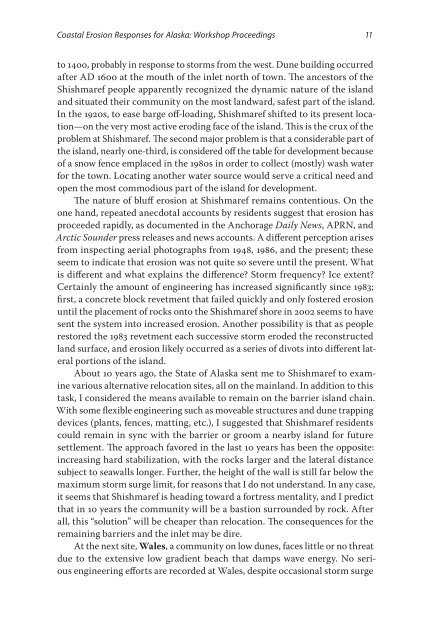Coastal Erosion Responses for Alaska - the National Sea Grant ...
Coastal Erosion Responses for Alaska - the National Sea Grant ...
Coastal Erosion Responses for Alaska - the National Sea Grant ...
Create successful ePaper yourself
Turn your PDF publications into a flip-book with our unique Google optimized e-Paper software.
<strong>Coastal</strong> <strong>Erosion</strong> <strong>Responses</strong> <strong>for</strong> <strong>Alaska</strong>: Workshop Proceedings<br />
<br />
to 1400, probably in response to storms from <strong>the</strong> west. Dune building occurred<br />
after AD 1600 at <strong>the</strong> mouth of <strong>the</strong> inlet north of town. The ancestors of <strong>the</strong><br />
Shishmaref people apparently recognized <strong>the</strong> dynamic nature of <strong>the</strong> island<br />
and situated <strong>the</strong>ir community on <strong>the</strong> most landward, safest part of <strong>the</strong> island.<br />
In <strong>the</strong> 1920s, to ease barge off-loading, Shishmaref shifted to its present location—on<br />
<strong>the</strong> very most active eroding face of <strong>the</strong> island. This is <strong>the</strong> crux of <strong>the</strong><br />
problem at Shishmaref. The second major problem is that a considerable part of<br />
<strong>the</strong> island, nearly one-third, is considered off <strong>the</strong> table <strong>for</strong> development because<br />
of a snow fence emplaced in <strong>the</strong> 1980s in order to collect (mostly) wash water<br />
<strong>for</strong> <strong>the</strong> town. Locating ano<strong>the</strong>r water source would serve a critical need and<br />
open <strong>the</strong> most commodious part of <strong>the</strong> island <strong>for</strong> development.<br />
The nature of bluff erosion at Shishmaref remains contentious. On <strong>the</strong><br />
one hand, repeated anecdotal accounts by residents suggest that erosion has<br />
proceeded rapidly, as documented in <strong>the</strong> Anchorage Daily News, APRN, and<br />
Arctic Sounder press releases and news accounts. A different perception arises<br />
from inspecting aerial photographs from 1948, 1986, and <strong>the</strong> present; <strong>the</strong>se<br />
seem to indicate that erosion was not quite so severe until <strong>the</strong> present. What<br />
is different and what explains <strong>the</strong> difference? Storm frequency? Ice extent?<br />
Certainly <strong>the</strong> amount of engineering has increased significantly since 1983;<br />
first, a concrete block revetment that failed quickly and only fostered erosion<br />
until <strong>the</strong> placement of rocks onto <strong>the</strong> Shishmaref shore in 2002 seems to have<br />
sent <strong>the</strong> system into increased erosion. Ano<strong>the</strong>r possibility is that as people<br />
restored <strong>the</strong> 1983 revetment each successive storm eroded <strong>the</strong> reconstructed<br />
land surface, and erosion likely occurred as a series of divots into different lateral<br />
portions of <strong>the</strong> island.<br />
About 10 years ago, <strong>the</strong> State of <strong>Alaska</strong> sent me to Shishmaref to examine<br />
various alternative relocation sites, all on <strong>the</strong> mainland. In addition to this<br />
task, I considered <strong>the</strong> means available to remain on <strong>the</strong> barrier island chain.<br />
With some flexible engineering such as moveable structures and dune trapping<br />
devices (plants, fences, matting, etc.), I suggested that Shishmaref residents<br />
could remain in sync with <strong>the</strong> barrier or groom a nearby island <strong>for</strong> future<br />
settlement. The approach favored in <strong>the</strong> last 10 years has been <strong>the</strong> opposite:<br />
increasing hard stabilization, with <strong>the</strong> rocks larger and <strong>the</strong> lateral distance<br />
subject to seawalls longer. Fur<strong>the</strong>r, <strong>the</strong> height of <strong>the</strong> wall is still far below <strong>the</strong><br />
maximum storm surge limit, <strong>for</strong> reasons that I do not understand. In any case,<br />
it seems that Shishmaref is heading toward a <strong>for</strong>tress mentality, and I predict<br />
that in 10 years <strong>the</strong> community will be a bastion surrounded by rock. After<br />
all, this “solution” will be cheaper than relocation. The consequences <strong>for</strong> <strong>the</strong><br />
remaining barriers and <strong>the</strong> inlet may be dire.<br />
At <strong>the</strong> next site, Wales, a community on low dunes, faces little or no threat<br />
due to <strong>the</strong> extensive low gradient beach that damps wave energy. No serious<br />
engineering ef<strong>for</strong>ts are recorded at Wales, despite occasional storm surge















